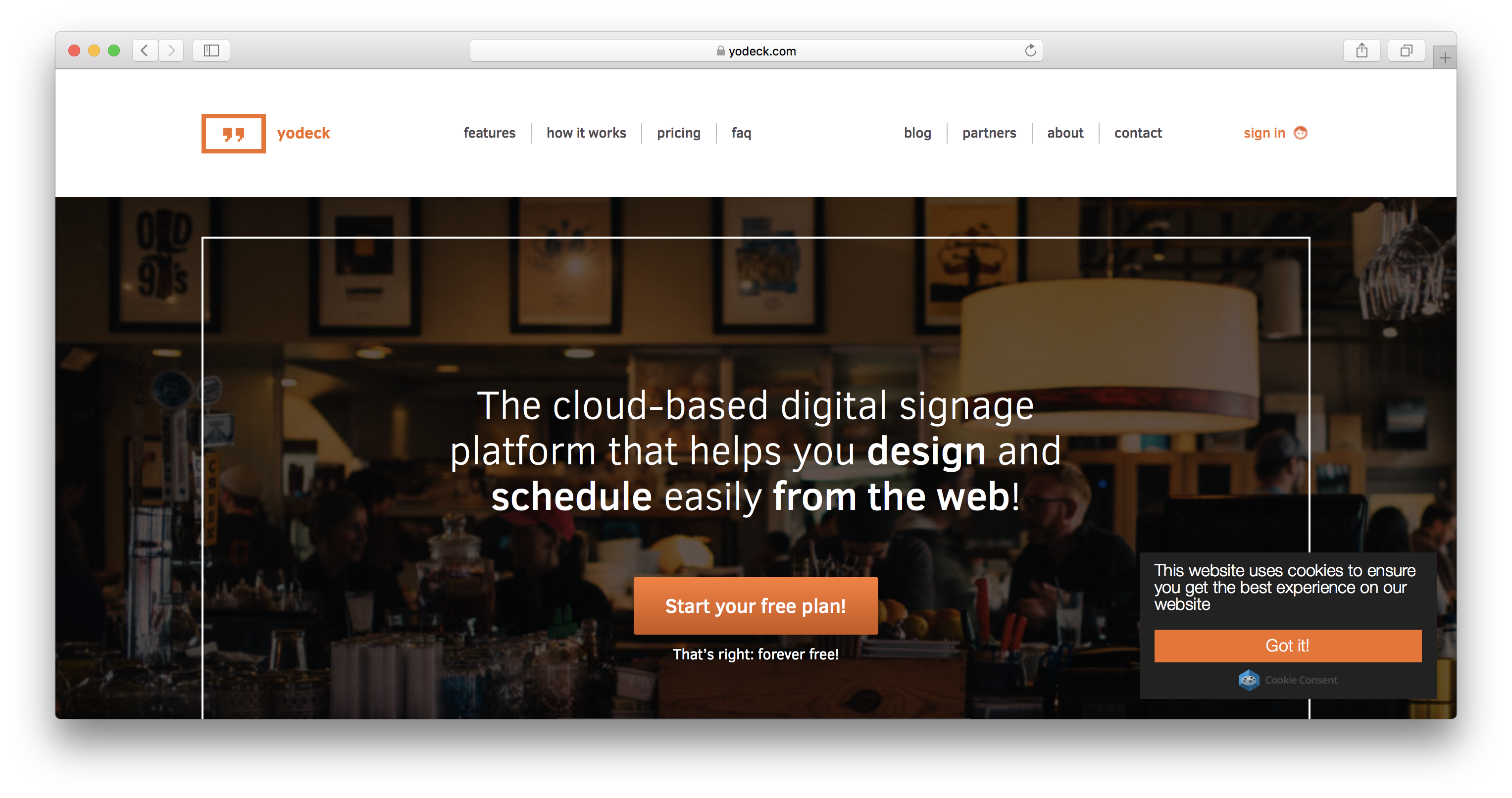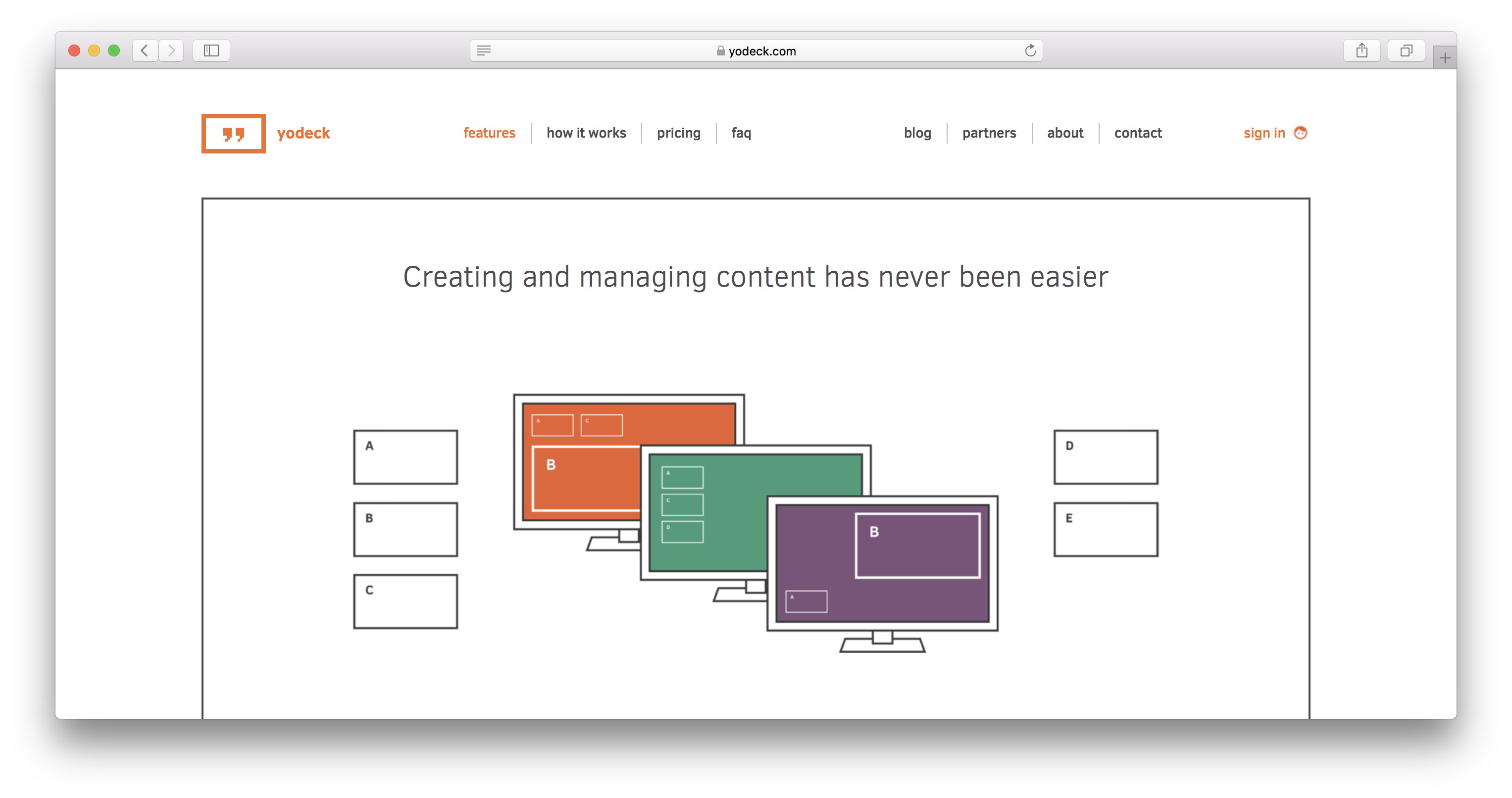Yodeck is a digital signage software solution that enables its users to create and schedule their monitors easily online, utilizing their tablet, computer or smartphone. The program is flexible enough it can be used on any screen ratio. It can also process a wide array of file formats, which include audio-video presentations and YouTube clips.
What does Yodeck do?
Yodeck is a hardware-reliant software solution—it ships in a pre-configured plug-and-play player called a “Yodeck Playbox” that can be—like an everyday, run-of-the-mill DVD player—installed by anyone. Thus, to explain what it does, it’s important readers get a grasp on how the hardware aspect works.
The Yodeck package contains the Yodeck Playbox, a three-foot HDMI cable, a micro USB power cable and an 8 GB SD card that comes pre-loaded with proprietary Yodeck software. The Playbox can connect directly to the user’s display via an HDMI cable and can connect to the internet in one of two ways: A Wi-Fi connection or via an RJ-45 cable. Users connect the power cable to the Playbox, connect the latter to a display and the internet, power the whole thing up, and they’re ready go.
There are several things mentioned in the manual that are worth noting though:
- Wait for at least 10 seconds for the Playbox to fully boot.
- Make sure the display is on and that the display’s source is set to the input that the Playbox is connected to (HDMI, etc).
- If the Playbox is being displayed as being “offline,” the user should consider using a LAN cable instead of depending on a Wi-Fi connection. An alternative solution: The user should detach the
- LAN cable (or Wi-Fi adapter), wait for another 10 seconds, and plug the entire thing again.
The rest of the setup process is as easy as what’s delineated above: The user creates a Yodeck account, makes sure the Yodeck Playbox and display are properly set up and running, uploads videos or images, appends them to a show, hits the apply button and that’s it—as user-friendly as it can get.

As it is readily apparent, the Yodeck Playbox is Yodeck’s proprietary plug-and-play player. It’s a heavily modified Raspberry Pi3 computer that can handle playback of whatever media the user wants to run on his/her display. It has also been engineered around the ubiquitous 1920X1080 display resolution. However, it’s worth noting that the Playbox can automatically adapt to any display and any resolution, even ones that do not support widescreen aspect ratios.
When a user powers up his/her Yodeck Playbox, he or she can immediately choose from four user-friendly “concepts”: Playlists, Widgets, Shows and Media. Playlists are a collection of media that get played sequentially with a user-specified duration. Media are user-uploaded or user-generated things that get displayed. Some examples are: images files and video clips. Widgets are small applications that display useful data like Rich Text and RSS feeds. Shows are a compilation of media, widgets and playlists, which are arranged on a virtual monitor.
After creating the shows, the user can just then assign a specific show to each of the monitors he/she is managing.
If desired, users can also assign each show to a specific schedule, which then governs which shows get loaded at which time. Using this system, users can setup different shows for different days or hours. They can even make a specific show display only within a specified timeframe.
This feature is also helpful where electricity bills are concerned as users can specify the hours where the displays are to power deactivate.
Moreover, the developers tout that in case of an internet outage, screens powered by the Yodeck system will still continue to display shows up to a full month. This is possible as content that is being displayed is downloaded and played from user-defined local sources. It’s worth noting though that users cannot change the shows being displayed until they reconnect to the internet. Also, content that is streamed from the internet—like those from web pages—needless to say, will not be available if the user’s internet connection is disrupted.

The benefits conferred by Yodeck
The core operations of what makes Yodeck tick have been explained. What follows is a list of benefits users get when using Yodeck.
- Use and recycle content in a convenient way—upload videos and/or images of varying file types, including YouTube clips and web pages.
- Anything fed to the Yodeck system is automatically tweaked so it can be played back without a hitch.
- Yodeck uses a bank-grade encryption system, which includes a firewall.
- Users can mix and match their own widgets if they wish to create custom-tailored content like a dynamic chart. They can even opt to use one of Yodeck’s pre-made widgets.
- Yodeck Playboxes are simple, plug-and-play affairs that anyone—even those without techie knowledge—can set up. They also support Wi-Fi or an Ethernet connection. Static IPs and proxies are also supported.
- The Yodeck system has an exhaustive management GUI to manage any number of displays—from just a single lowly 1080p monitors to hundreds of vertical screens.
- User-friendly GUI: Yodeck has a drag-and-drop layout interface.
- Mobile-friendly: Yodeck’s management GUI can run on mobile browsers, unfettering users from their dependence on desktop PCs.
- The system has a technical support team.
Pricing plans
Yodeck offers a free plan for users with just a single display. However, for users who plan to use multiple ones, Yodeck charges them based on the maximum amount of monitors they plan to deploy. Users who have an extensive enterprise that utilizes more than a hundred monitors can contact Yodeck’s sales team for a quotation. The system is scalable so users who have a thousand or more monitors need not fret—the developers are touting they can run an operation of that magnitude.
The pricing plans are also scalable, which means whenever you add more monitors Yodeck can readily take that into account and the operation will still run without having to tweak the system hardware- and software-wise.
The company offers three pricing plans. These are Free, Pro and custom.
The Free plan is, as its name signifies, free. Even then, it’s far from being a barebones bundle, allowing users to have unlimited storage and bandwidth, full technical team support and works with a Raspberry Pi device. Alternatively, users can opt to get the Yodeck Playbox. This will, however, cost them $79 plus a shipping fee.
The Pro bundle comes in two variants: Monthly and Annual. The former costs $7.99 a month per display and has all the features covered by the Free plan. The latter is priced at $95.88 a year per monitor, comes with all the features of the Free plan but it comes with a free Yodeck Playbox for each of the user’s monitors. Note that both Pro variants get priority tech support over users who have availed of the Free plan.
The Custom plan can be availed of if the user opts for a quotation. This option is best for users who plan to operate—or are operating—more than a thousand monitors. Except, of course, for the price, the Custom plan comes with all the perks detailed in the Annual plan.
Conclusion
The very embodiment of the term user-friendly, Yodeck is one of the most ideal software solutions where digital signage businesses are concerned. Proprietors of such ventures should check out this offering and see if it suits their needs.